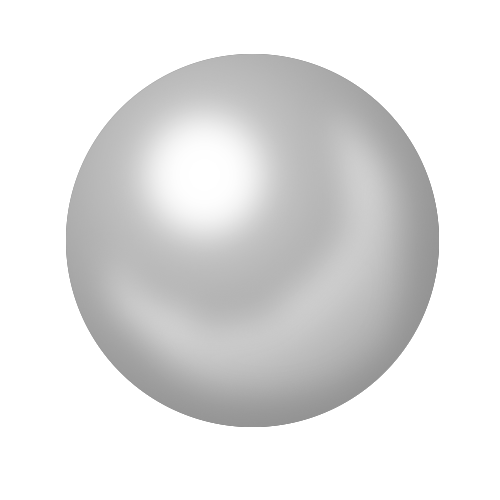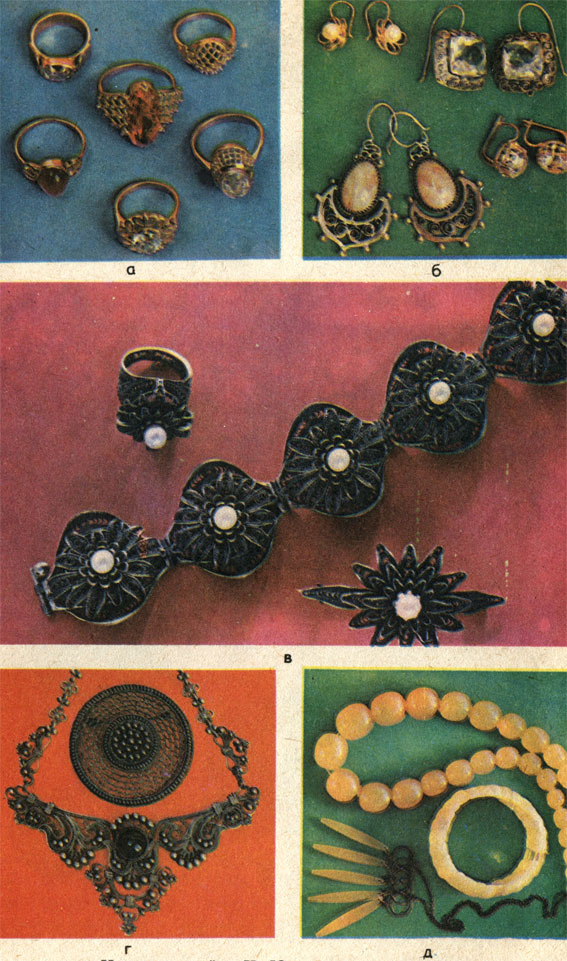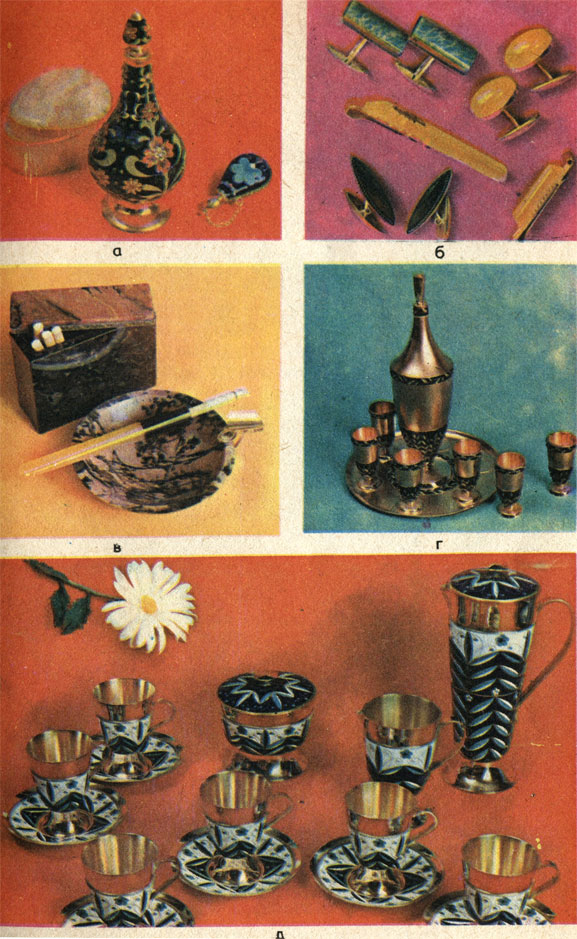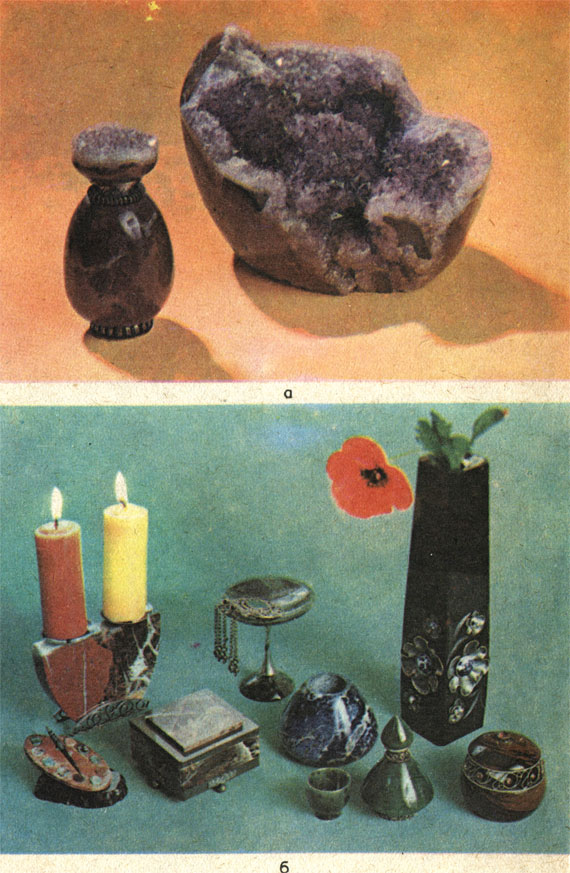Semiprecious stones. White and colorless color in precious and "semi-precious" stones
From this article you will learn which stones are colorless or white.
17 August 2016
It is believed that a person's desire to wear white minerals speaks of his desire for purification and spiritual growth. Opaque white "semi-precious" stones are great for everyday wear, while transparent colorless gems are appropriate for evening events.
Learn about main reason the emergence of color in precious stones and the main components of the color of the stone in our article on the color of the DK.
Others physical properties are a color that is not normally diagnostic, luminescence, phosphorescence, and brilliance, that is, what a crystal exhibits when light is reflected. As a rule, there is a metallic, sub-metallic and non-metallic luster. It also talks about the brightest glitter like diamond and zirconia.
In minerals belonging to the monometric system, this deviation occurs in the refractive index, which takes the same value in any direction of the crystal, and this phenomenon is called simple refraction. However, there is a direction in deflated minerals in crystals, called dimers, and two directions in trimeters, along which there is no phenomenon of double refraction. Observing the transparency of a transparent mineral in a microscope, one can recognize the so-called inertial figures, which allow one to determine the position of the optical axis and distinguish between a dimeric mineral, in which there is only one optical axis, in trimetry, where there are two optics axes. These minerals are analyzed by polished mirror sections capable of reflecting large quantity accidents with light radiation. One of the recognizable features of this type of crystal is the reflectivity, which depends on the refractive index and the absorption coefficient. Generally, minerals are classified according to the type of atom they belong to. This class includes all elements that are naturally in their original state.

On the picture: zircon from Cambodia, 8.92 carats
Zircon- natural "semi-precious" stone, which, depending on the content of various impurities, can have almost any color. Transparent colorless zircons contain a minimum of impurities; abroad they are called white zircons (white zircon). In faceted form, they are characterized by a very strong play of color flashes and a noticeable effect of birefringence. Due to the external similarity, today such zircons in products can be an excellent alternative to diamonds. Note that many colorless zircons are obtained by heat treatment of brown zircons. "White" zircons today come to the world market mainly from Tanzania and Cambodia.
Recognized are metallic elements, non-metallic elements and a few semi-metallic elements. Appearance: Usually in compact masses, even of considerable size. Cubic or octahedral crystals are rare. Property: tender or not very hard, very heavy, no gap.
Learning: It is formed by chemical processes. Usage: Rarely used in industry. It is currently being exploited in the field of electrical engineering to form wires and cables. Appearance: Often found in compact or filamentous masses.
colorless sapphire- transparent gem, a type of corundum. The second name for colorless sapphire is leucosapphire. With poor transparency, it may look white due to the large number of tiny whitish inclusions of rutile. In large, almost colorless sapphires, you can sometimes notice a slight tint, for example, blue, purple or yellow. Colorless sapphires have high hardness and excellent brilliance. In jewelry, they can also be an alternative to more expensive diamonds. The extraction of such sapphires is mainly carried out in Sri Lanka.
Properties: soft or slightly hard, very heavy, malleable, opaque with a metallic sheen. Training: Frequent in lead-zinc fields and in hydrothermal environments. Uses: It is currently used in photography, chemistry, jewelry, and electronics.
Appearance: It is distributed in small and informal granules. Property: not rigid, heavy, malleable, matte with a metallic sheen. Teaching: Typically derived from formations of sedimentary origin and often found in natural alloy with silver.
![]()
On the picture: colorless sapphire, 5.40 ct, Sri Lanka

An unusual jewelry material that forms inside the body of molluscs. It consists of alternating layers of organic conchiolin and the mineral aragonite. In Russia, sea natural pearls are considered a precious stone. Usually pearls are white, but can be gray, black, gold, pink, etc. There are many types of pearls. Almost all pearls on sale today are cultured. The shape of pearls is usually imperfect, they are often oval, teardrop-shaped. Perfectly smooth round pearls are the most valuable.
Usage: Commercially used metal. Appearance: frequent crystals with a bipyramid dress. Property: not stiff, very light, brittle, difficult to sieve. Formation: It is formed in evaporative type sediments. Uses: Used for the production of sulfuric acid, for the production of explosives and fertilizers.
Appearance: It is often found in deciduous masses, black. Patented: very tired, greasy to the touch, perfectly removable. Learning: frequent in metamorphic rocks. Application: In industry it is used to produce lubricants, electrodes, pencils and dyes.
In the photo on the left: white pearl Pictured : white opal from Australia, 20.82 carats
Opal- a gemstone that combines a number of varieties. The name "opal" is translated as "bewitching sight" (from Latin "opalus"), and in Sanskrit "fell" - a noble stone. Among its types, the so-called "white opals" with a light base tone are distinguished. At the same time, opalescence can be observed in them in the form of bright iridescent colored spots. The most transparent white opals are mined in Ethiopia, the color of which ranges from light yellowish tones to bluish. The most expensive opals of this variety are found in Australia. They are also found in Brazil.
Appearance: Octahedral, round and colorless crystals. Property: This is the heaviest substance, it is heavy, brittle with perfect flaking. Training: frequent in ultrabasic breeds. Use: This is a precious and highly valued gem. The first diamond appears to have been discovered in 800 in India, although it was probably known to the Romans and Greeks.
This class refers to minerals formed by a combination of metals and semimetals with sulfur. Sulfides are characterized by structures consisting predominantly of covalent bonds. Metal reflections are opaque. Appearance: Spotted cubic crystals, octahedral. Often it is compact or granular aggregates. Darker yellow is diagnostic. Frequencies are pseudomorphs on fossil remains.
Diamond- the most expensive gemstone, which can be completely colorless. Occasionally, diamonds are translucent or opaque milky white. Cut diamonds are called brilliants. In composition, they are crystalline carbon, and in the absence of impurities they will be absolutely colorless. More often, diamonds are characterized by the content of nitrogen, which gives them a yellowish tint. The less yellowish in the stone, the more expensive it will be. The peculiarity of diamond is that it is the hardest natural mineral (10 on the Mohs scale), and it has a very strong dispersion.
Property: tough, very heavy, poorly flaky, brittle. Learning: found in volcanic, sedimentary and metamorphic rocks. It is often associated with calcipyrite, galena and mixture. Uses: This is a mineral used to produce sulfuric acid.
Appearance: It is usually presented in compact masses of a bronze-pink color, and the crystals, quite rare, are tabular and ragged. Properties: Rigid, very heavy, strongly flush with a shortened fracture. Education: It is usually present in hydrothermal vents or associated with silver, nickel, or cobalt sulfides in gabbro.
In the photo on the right: 2.46 carat diamond

Of the colorless "semi-precious" stones, topaz and quartz (rock crystal) are the most accessible. White quartz is called milky quartz. In faceted form, there are also rare colorless tourmalines (achroites) and beryls (goshenites, rosterites), phenakites, euclases, danburites, etc., highly valued among collectors. Opaque cacholong (an intermediate variety between opal and chalcedony) and rare white jade.
Uses: Used to extract nickel. They have a relatively simple chemical composition, colorless or slightly colored, delicate and soluble in water. Structurally, they consist of ionic bonds. Their formation is associated with the evaporation of salt lakes or sea urchins.
Oxides are minerals that form when certain metal cations combine with oxygen. Oxidizing ions are also present in the hydroxide structure. Among the oxides we remember: Spinello, magnetite, hematite, corundum, quartz. Appearance: Hexagonal prismatic crystals, sometimes large. It is generally white, but infiltration of foreign matter can produce different colors.
You can get acquainted with stones of various colors in the Gem Lovers catalog.
Semi-precious stones are mainly transparent, colorless or colored stones, the color of which, depending on the impurities they contain, varies. Sometimes the color is different in the same mineral, and therefore the stones have different names. The internal structure, chemical composition, physical (including optical) properties of semi-precious stones are different.
Ownership: very severe, no decompression, with a pronounced contralateral fracture. Quartz polymorphs are well known, such as cristobalite and tridymite. Workout: Quartz is one of the most common minerals in the earth's crust. It occurs in igneous rocks and is also present in sedimentary detrital rocks.
Uses: has piezoelectricity and is used to make special pressure gauges and pulse generators; It is also UV transparent and is used to make healing lamps, prisms and spotted lenses. Its colorful varieties are prized by collectors, and fine gemstones are especially beautiful. Among the varieties we remember Amethyst, rose quartz, tiger's eye, quartz quartz.
Semi-precious stones include chrysolite, spinel, amethyst, aquamarine, beryl, chrysoberyl, topaz, tourmaline, zircon, hyacinth, chrysoprase, almandine, garnet, opal, moonstone, turquoise, coral, rock crystal, smoky and yellow quartz, rauchtopaz, morion , quartz-hairy, etc.
Chrysolite. It is a transparent yellowish green to deep green mineral with a strong vitreous luster. The most highly valued chrysolite is a dense green color. Chrysolite is a rare stone; it has double refraction; is a variety of the mineral olivine; In composition, chrysolite is magnesium and iron silicate. The hardness of chrysolite is 6.5-7. Density 3.32-3.5 g/cm 3 , refractive index 1.66.
Appearance: Rhombohedral, black, flattened, lamellar crystals arranged like rose petals. Property: Rigid, very heavy, no spatter, matte with a metallic sheen. Learning: Common in volcanic rocks, especially lava. In a sedimentary environment, it can be formed by the diamogenesis of limonite.
Uses: This is the most used industrial iron ore. The most common carbonates, usually white or slightly colored, have a hardness less than. Appearance: rhombohedral, scalenohedral or prismatic crystals. Properties: semi-rigid, light, easy to clean, transparent with a vitreous mother-of-pearl luster. Polymorphs are common, including Aragonite and Vaterite.
Chrysolite is sometimes mistaken for apatite or beryl, which have the same color. These stones have a strong brilliance, and beryl is not inferior in hardness (7.5-8) to chrysolite. Sometimes chrysolite is also incorrectly called close to chemical composition to a group of garnets stone daemonoid, which is green.
Oriental chrysolite is called olive-colored corundum, which, when illuminated, loses its original color and becomes reddish-brown.
Teaching: A mineral that is formed by chemical precipitation, or by evaporation of solutions rich in calcium carbonate. Usage: Calcite crystals are used to build polarizing prisms used for mineralogy microscopes. Also in construction, calcite is used to make decorative stones and stones. The mineral is also used in fertilizers and the chemical industry.
Appearance: Elongated prismatic crystals, often clustered to form typical twins, mimicking the prismatic hexagonal shape. Property: semi-rigid, heavy, complex, brittle and transparent. Training: This is polymorphism high pressure calcite, so it is stable only under certain physical conditions.
Spinel. Transparent stone of carmine, dark pink, blood-red, reddish-brown, violet and blue colors. The most valuable is spinel of carmine and ruby colors without a yellowish tint. Spinel consists of alumina and magnesium oxide, has high transparency and a strong glassy greasy luster. Spinel hardness 8-8.25. Density 3.6 g/cm 3 , refractive index 1.71-1.74.
Usage: It doesn't have of great importance but is prized by collectors. Non-metallic are minerals in which the anionic group is formed by an oxygen tetrahedron with a silicon atom in the depth. Among the minerals belonging to this class, the most famous are: anhydride, celestine, baritine and gypsum.
Appearance: Tabular, lenticular, colorless or variable colored crystals. Properties: semi-rigid, very heavy, perfect, brittle and transparent. Drill: It is commonly found in hydrothermal vents associated with lead, silver, and antimony sulfides.
Some varieties of spinels are similar in color to real rubies, differing from the latter in the internal structure of the crystals. Spinel of pink and dark pink colors is called ruby-bale, yellowish-red or orange - scarlet, with a reddish-violet tint - almandine spinel. Under the action of light, the spinel gradually loses its original color.
Used: used to extract barium, and in the paper and rubber industries. Appearance: Tabular crystals, elongated, transparent, often dovetailed, sometimes grouped into compact and granular masses. Properties: delicate, perfectly transparent in sheets, light.
Training: A sedimentary mineral of chemical origin, usually formed in an evaporative environment by precipitation of mother liquors or by hydration of anhydride. Used by: A mineral used to make plaster and plaster, and is an important ceramic foundry and fertilizer.
Amethyst. Being a variety of quartz, amethyst is a transparent mineral from light to thick. purple with a reddish tint and a glassy sheen (see color insert I, 4). There are amethysts of greenish-blue and black-violet colors. Deep-violet amethysts are especially valued, weakly colored amethysts are less. Uniformly colored crystals are rare, most often the color intensifies towards the top of the crystal.
They also differ in the formation of numerous polymorphic series. A well-known mineral belonging to this class is Turquoise, which is precious and especially beautiful. decorative stone. Silicates make up about 95% of the known part of the earth's crust, so they are very important minerals. Many of these minerals occur in igneous rocks, others in metamorphic ones.
They crystallize in the cubic system and are quite widespread in nature. Many garnets are colored, and different varieties also vary in color. Appearance: Isolated crystals, often very large, hexagonal prismatic, of various colors.
The best amethyst is considered to be the Ural amethyst, which does not lose color under artificial lighting, retaining its brilliance and beauty. Amethysts from other deposits take on a grayish tint in the evening light. Amethyst hardness 7, density 2.6 g/cm 3 , refractive index 1.56.
Aquamarine. This is a transparent stone, usually of a pale blue color, which is why it got its name (from the Latin "aquamarine" - sea water). There are aquamarines greenish-blue, blue-green and colorless. Aquamarine (see color insert I, 5) is a variety of beryl, similar in composition to emerald, and has a vitreous luster. Hardness 7.5-8, density 2.6-2.8 g/cm 3 , refractive index 1.58.
Property: hard, light, usually transparent with a vitreous luster. Teaching: Present in volcanic rocks, often associated with quartz. Usage: It is important in the nuclear industry. Its variety is the Emerald, a gemstone that is highly sought after and appreciated.
Appearance: prismatic crystals, elongated, usually vertically striated, of various colors. Property: heavy, heavy, transparent with vitreous luster. Training: common in igneous and metamorphic rocks. Usage: Piezoelectric mineral is used for the construction of high pressure gauges. Some of its colorful varieties are considered precious.
Beryl. It is a transparent mineral of various colors: golden yellow (golden beryl), greenish (noble beryl), cherry pink and pale pink (sparrow and morganite). The hardness and other indicators of beryl are the same as aquamarine.
Chrysoberyl. Transparent stone of green, golden-green, yellow or golden color with overflows (see color insert I, 6). Colorless chrysoberyls are also known.
Particularly valuable is a dark green variety of chrysoberyl, called alexandrite. This is a very rare stone, which under artificial lighting loses its green color and acquires a purple-raspberry color, and during the day in strong sunlight - a bluish-green color with purple tints. Under the name "alexandrite" is known synthetic corundum, which has a grassy-green color, turning into pink with purple tints under artificial lighting. The hardness of chrysoberyl is 8.5, the density is 3.6-3.8 g/cm 3 , the refractive index is 1.76.
Topaz. The transparent mineral is usually deep orange, wine yellow and straw yellow. There are topazes of light blue, bluish-green, pale green, pink, various shades of purple and colorless. The best topaz is wine-yellow and yellowish with a reddish tint. Topaz is sometimes called "heavyweight". Topaz consists of silica, alumina and fluorine. Hardness 8, density 3.5 g/cm 3 , refractive index 1.62.
"Heavyweight" topaz should not be confused with the yellow or smoky-colored stone often found in jewelry, which is a variety of quartz that is incorrectly called golden topaz (yellow quartz) and smoky topaz (smoky quartz) in everyday life. Topaz "heavyweight" differs from yellow and smoky quartz both in composition and in hardness. The hardness of quartz is 7, topaz is much heavier than quartz.
Light blue and bluish green topaz is sometimes mistaken for aquamarine, and pale green topaz for emerald. Distinctive features can be hardness and density, which are higher in topaz than in aquamarine, quartz and emerald.
Tourmaline. A transparent mineral of complex and diverse chemical composition (boron aluminosilicate). The color of tourmaline is carmine red, dark crimson and light pink; tourmaline is found in emerald green, yellow, green-yellow, blue-green, blue, purple, brown, black and colorless. The best is raspberry-colored tourmaline, which loses its beautiful color under artificial lighting.
Tourmalines of carmine-red color are sometimes called rubelite and siberite, blue - indicolite, brown - dravite, pink - apyrite, purple - agnite, black - schorl and colorless - achront. Tourmaline hardness is 7-7.5, density is 2.9-3.2 g/cm 3 , refractive index is 1.63. This is a fragile stone.
Zircon. It is a transparent stone of reddish-brown, brownish-yellow, greenish-yellow and brown colors (see color insert I, 7), consisting of silica with zirconium oxide. The hardness of zircon is 7-8, the density is 3.9-4.2 g/cm 3 , the refractive index is 1.78-1.81.
Hyacinth. As a variety of zircon, hyacinth is a transparent, lustrous stone that comes in raspberry-orange, reddish-orange, yellow-orange, and brown; there are also greenish, purple and colorless hyacinths. Colorless hyacinth can be obtained artificially by calcining the mineral. Hyacinth hardness 7-8, density 4.7 g/cm 3 , refractive index 1.92-1.97.



Chrysoprase. The stone has an apple-green color and is a cloudy-transparent mineral chalcedony (see color insert I, 8). Chrysoprase hardness 7, density 2.57 g/cm 3 , refractive index 1.53. Over time, chrysoprase gradually loses color under the action of light. However, the color is restored if the stone is placed in a humid environment.
Almandine. It. stone of crimson, bluish-red, cherry-red, reddish-brown and brownish-red colors (see color insert I, 9). It is a variety of the mineral garnet with a strong vitreous luster close to oily. In ancient times, almandine was called a carbuncle. Some types of almandine are similar in color to spinel and even ruby. Almandine hardness is 6.5-7.5, density is 3.9-4.2 g/cm 3 , refractive index is 1.78-1.81.
Garnet. The color of the garnet has more than 30 shades and, depending on the color, it can be transparent, translucent and opaque. It consists of silicic acid and metal oxides. Garnet hardness 6.5-7.5, density 4.0-4.3 g/cm 3 , refractive index 1.93. The shape of garnet crystals resemble grains, hence its name (from the Latin "garnet" - similar to grains).
The most beautiful fan of blood-red color with a fiery hue is called pyrope.
Garnet is one of the most common stones in jewelry; blood-red garnet is used as jewelry inserts, for the manufacture of beads and other products.
There is an emerald green garnet, called uvarovite, whose hardness is 8, i.e., higher than other varieties of garnet. Brown garnet is called essonite, brownish-red or reddish-brown - blush, apple-green - grossular, black with a strong glassy sheen - melanite, blackish-brown - pereneite, yellow-brown - rotophyte, bright yellow - topazolite or succinite, yellowish-brown with a resinous sheen - colophonite.
Opal. This is a translucent, iridescent (see section Different materials for jewelry, this edition) stone, amorphous structure, consisting of silica with minor impurities of iron oxide, alumina, lime and containing from 1 to 15% water. This is a fragile stone. Opal hardness 5.5-6, density 2-2.2 g/cm 3 , refractive index 1.44-1.46.
White or milky-white opal with a strong luster, tint and with an iridescent play of various colors is called noble, a yellowish color is golden; there is an opal of the color of carpenter's glue, which, when immersed in a glass of water, acquires the game of milky white opal. This opal is called hydrophane or water opal. There are other varieties of opal - fire, or wax, reddish-copper and whitish-red, having the play of noble opal, as well as opals of green, blue, purple, pink and black.
Moonstone, or adularia. It has a transparent milky color with a pearly sheen (see color insert I, 10) and is a variety of feldspar. The hardness of the moonstone is 6, the density is 2.53-2.58 g / cm 3. Refractive index 1.53. For inserts in jewelry, it is usually cut into a cabochon shape.
Turquoise. Turquoise (from Persian, "firuza" - a stone of happiness) - an opaque mineral of an amorphous structure of a sky-blue color; there is turquoise greenish-bluish and blue with a spotted reddish-brown color of a complex ornate pattern. Chemically, turquoise is a hydrous phosphate with traces of copper. The hardness of turquoise is 5-6, the density is 2.6-2.83 g / cm 3. Differs in fragility. With prolonged wear, turquoise loses its original qualities and color under the influence of sweat and fat. Turquoise is used in all types of jewelry and cut cabochon.
Rhinestone. It is a glassy mineral, which is a crystalline variety of quartz. Vitreous quartz is transparent and colorless, smoky, yellow, purple and black. rock crystal It is customary to call a completely transparent and colorless vitreous stone. Compared to other stones or glass, rock crystal feels cold to the touch. In ancient times, rock crystal was considered petrified ice.
The chemical composition of rock crystal is silica. Its hardness is 7, density is 2.65 g/cm 3 , refractive index is 1.55. This is one of the most common and inexpensive stones. It is used for inserts into jewelry, cutting beads and as an ornamental material for the manufacture of various artistic and decorative products.
Smoky and Yellow Quartz. They are varieties rock crystal.
smoky quartz has a smoky color due to impurities of bituminous compositions. Sometimes smoky quartz is called rauchtopaz. Its color is uneven, from light to dark brown and smoky brown. This stone is used for the same products as rock crystal.
yellow quartz- a yellow stone, sometimes with a brownish tint (see color insert I, 11). It can be obtained artificially by weak firing of smoky quartz. Yellow quartz is used to make jewelry and faceted beads.
Morion. This is a variety of smoky quartz, almost completely black in color. It is used for inserts into jewelry, both in the form of smooth polished square and rectangular shapes, and in the form of gems.
hairy quartz. The stone is a kind of rock crystal with ingrown finest crystals of rutile, schorl and other minerals. It was very popular in Russia in the 18th century, it was called moss crystal and hairy. In Western Europe, it was known as the stone with the hair of Venus. In hairy quartz, rutile is present in the form of thin long golden needles and bundles, which sparkle and sparkle in bright sunlight, creating an unusual effect. Hairy quartz is used for inserts into rings, earrings, brooches, pendants and other products.
